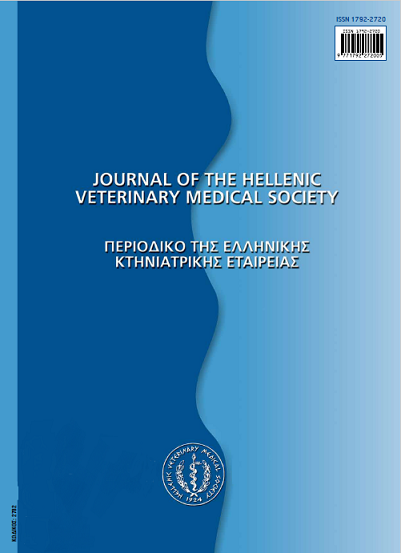Εωσινοφιλική δερματίτιδα με οίδημα σε σκύλο (Wells'-like syndrome) μετά απο κατανάλωση ψαριών

Περίληψη
Μια σκΰλα δυο ετών, ακαθόριστης φυλής, προσκομίστηκε με πολυεστιακές δερματικές αλλοιώσεις που εμφανίστηκαν αιφνίδια και επεκτείνονταν συμμετρικά στον κορμό του σώματος. Το ζώο αυτό ζοΰσε μέσα στο σπίτι και είχε καταναλώσει μαγειρεμένα ψάρια μία ήμερα πριν από την προσκόμιση, ενώ δεν του είχαν χορηγηθεί φάρμακα ή εμβόλια τους 3 τελευταίους μήνες. Κατά την κλινική εξέταση διαπιστώθηκαν μη κνησμώδεις και ανώδυνοι πομφοί, βλαττίδες και πλάκεςπου κατανέμονταν κυρίως στην κεφαλή, τα πτερύγια των αυτιών, τον τράχηλο και τα τοιχώματα του θώρακα. Οι δερματικές αυτές αλλοιώσεις ήταν κυκλοτερείς, τοξοειδείς ή οφιοειδείς με τάση συνάθροισης. Η ιστοπαθολογική εξέταση αποκάλυψε την ύπαρξη οιδήματος στο επιπολής χόριο, συμφόρηση των μετα-τριχοειδών φλεβιδίων και περιαγγειακή-διάμεση εωσινοφιλική δερματίτιδα. Αρχικά στο σκύλο χορηγήθηκε από το στόμα βιταμίνη Ε, σουλφασαλαζίνη και δοξυκυκλίνη, χωρίς όμως αποτέλεσμα. Μετά την ιστοπαθολογική επιβεβαίωση της εωσινοφιλικής δερματίτιδας, η παραπάνω θεραπεία αντικαταστάθηκε από την πρεδνιζολόνη, από το στόμα, για 2 μήνες, κατά τη διάρκεια των οποίων ο σκύλος παρουσίασε σημαντική βελτίωσημέχρι την εξαφάνιση των δερματικών αλλοιώσεων, χωρίς στη συνέχεια να εμφανίσει υποτροπές. Το πιθανότερο αίτιο της εωσινοφιλικής αυτής αντίδρασης υπερευαισθησίας ήταν η κατανάλωση μαγειρεμένων ψαριών από το σκύλο αυτό.
Λεπτομέρειες άρθρου
- Πώς να δημιουργήσετε Αναφορές
-
GIANNOULOPOULOS (Γ.Δ. ΓΙΑΝΝΟΥΛΟΠΟΥΛΟΣ) G. D., FARMAKI (Ρ. ΦΑΡΜΑΚΗ) R., KOUTINAS (Χ.Κ. ΚΟΥΤΙΝΑΣ) C. K., & KOUTINAS (Α.Φ. ΚΟΥΤΙΝΑΣ) A. F. (2017). Εωσινοφιλική δερματίτιδα με οίδημα σε σκύλο (Wells’-like syndrome) μετά απο κατανάλωση ψαριών. Περιοδικό της Ελληνικής Κτηνιατρικής Εταιρείας, 62(4), 320–326. https://doi.org/10.12681/jhvms.14862
- Τεύχος
- Τόμ. 62 Αρ. 4 (2011)
- Ενότητα
- Case Report
Οι συγγραφείς των άρθρων που δημοσιεύονται στο περιοδικό διατηρούν τα δικαιώματα πνευματικής ιδιοκτησίας επί των άρθρων τους, δίνοντας στο περιοδικό το δικαίωμα της πρώτης δημοσίευσης.
Άρθρα που δημοσιεύονται στο περιοδικό διατίθενται με άδεια Creative Commons 4.0 Non Commercial και σύμφωνα με την άδεια μπορούν να χρησιμοποιούνται ελεύθερα, με αναφορά στο/στη συγγραφέα και στην πρώτη δημοσίευση για μη κερδοσκοπικούς σκοπούς.
Οι συγγραφείς μπορούν να καταθέσουν το άρθρο σε ιδρυματικό ή άλλο αποθετήριο ή/και να το δημοσιεύσουν σε άλλη έκδοση, με υποχρεωτική την αναφορά πρώτης δημοσίευσης στο J Hellenic Vet Med Soc
Οι συγγραφείς ενθαρρύνονται να καταθέσουν σε αποθετήριο ή να δημοσιεύσουν την εργασία τους στο διαδίκτυο πριν ή κατά τη διαδικασία υποβολής και αξιολόγησής της.










